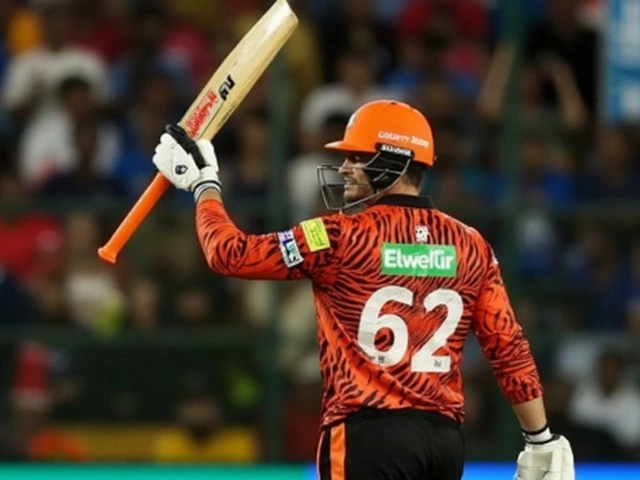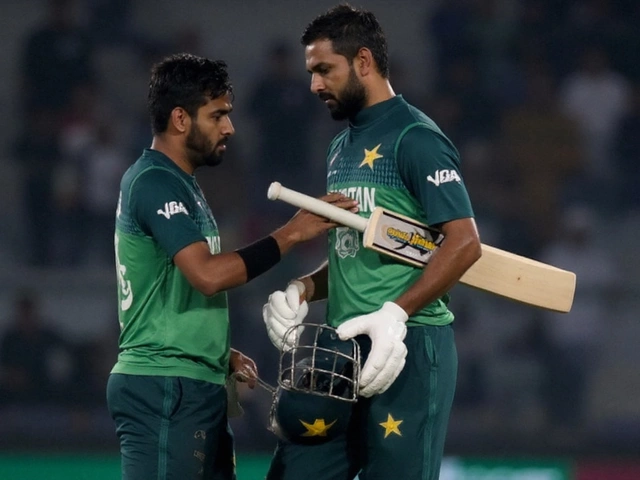Fakhar’s sudden exit, the silence in Karachi, and a Pakistan plan torn up days before India
On the second ball of Pakistan’s Champions Trophy 2025, the stadium in Karachi went quiet. Fakhar Zaman sprinted hard to cut off a Will Young drive off Shaheen Shah Afridi, pulled up clutching his side, and knew something had gone wrong. He tried to continue later—shuffled down to No. 4, took treatment between overs, and battled for 24 off 41—but his movement told the story. By night, the Pakistan Cricket Board confirmed the worst: an oblique tear. He is out of the tournament.
It is a brutal blow, made worse by the timing. Pakistan face India on Sunday in Dubai, the fixture that shapes reputations and seasons. Fakhar has lived that stage before. His century in the 2017 Champions Trophy final remains one of Pakistan’s defining one-day innings—a fearless, decisive knock that broke open the biggest game of his life. Take that aura out of the top order and the team’s balance shifts immediately.
The injury itself was as sudden as it was costly. Fakhar went down in the first over, spent more than two hours off the field getting treatment, and still tried to bat through painkillers. The oblique muscles—running along the side of the abdomen—are central to a batter’s rotation and a fielder’s explosive movement. Tears there are tricky. Even a mild one can sideline an athlete for weeks; a full tournament turnaround is rarely realistic. Pakistan’s medical team had little choice.
Pakistan have called up Imam-ul-Haq as the replacement. The 27-year-old left-hander brings a steady head and a strong ODI record—72 matches, 3,138 runs at an average of 48.3. Imam doesn’t mirror Fakhar’s method. Fakhar forces the pace early, hits through the line, and unsettles new-ball plans. Imam builds, plays risk-free percentages, and drags the innings into safer waters. The swap changes not just a name, but an entire opening philosophy.
This is Pakistan’s second hit at the top. Saim Ayub, who was in line to push for a starting role, had already been ruled out after twisting his ankle during the Test series in South Africa. Continuity at the top is gone, and with it the familiar rhythm that defines the first 10 overs. The coaches now have hours, not weeks, to redraw the batting blueprint.
Pakistan’s updated squad now reads: Mohammad Rizwan (captain), Babar Azam, Imam-ul-Haq, Kamran Ghulam, Saud Shakeel, Tayyab Tahir, Faheem Ashraf, Khushdil Shah, Salman Ali Agha, Usman Khan, Abrar Ahmed, Haris Rauf, Mohammad Hasnain, Naseem Shah, and Shaheen Shah Afridi.
Where does this leave Sunday? Pakistan’s management has two obvious tracks. One: go conservative up top, pair Imam with a senior stabilizer and push the game deep. Two: inject intent from the other end to replace the early hitting that Fakhar often supplies.
The first option points to Imam opening alongside Babar Azam, a partnership Pakistan know well in 50-over cricket. It is methodical, low-risk, and ideally suited to batting second or to surfaces where 280 is a winning score. The risk? India’s new-ball attack loves prolonged control. If the boundary count dries up, pressure mounts on the middle order to manufacture pace late.
The second option asks a different question altogether. Could Pakistan pair Imam with a more attacking foil—someone like Usman Khan—or push Mohammad Rizwan up to set the tone? Rizwan’s adaptability gives the think tank wriggle room, and he has opened in white-ball formats with success. If the team reads Dubai as a ground where the new ball slides on, starting with intent might be worth the gamble.
Then there’s the middle order, the part of this team that often lives in the shadow of the top three. Saud Shakeel’s timing, Salman Ali Agha’s busy game, Khushdil Shah’s power, and Tayyab Tahir’s range will now be tested in real pressure. Without Fakhar’s early boundaries, Pakistan may need 20 to 30 extra runs from overs 11 to 40—those half-gears that turn a par score into something defendable.
Bowling becomes the other lever. Shaheen Shah Afridi, Naseem Shah, and Haris Rauf can shift a match with the new ball and at the death, but they’ll want a score that lets them hunt wickets, not just defend gaps. Abrar Ahmed’s mystery spin offers a middle-overs choke if Pakistan get ahead of the game. In short: if the top order doesn’t punch early, the attack has to create that momentum with the ball.
So, what exactly is an oblique tear and why does it sideline batters so quickly? The obliques help rotate the torso—everything from a front-foot drive to a pull shot loads those muscles. Fielding dives and sudden turns can strain them, and once torn, every swing tests the area again. Players often feel fine standing still but struggle the moment they twist or stretch. Even with painkillers, movement is restricted and bat speed dips. Recovery is rest-led, with gradual core rehab, and rushing back risks a re-tear.
Fakhar’s determination was obvious in Karachi. He returned to bat when most would have shut it down, took repeated checks from the doctor and physio, and tried to find singles. It wasn’t sustainable. Later, he posted a short message on social media—pride in playing for Pakistan, acceptance of the setback, and a line about trusting the plan beyond his control. It read like a veteran making peace with a bad break.
Inside the dressing room, this kind of injury forces a mindset shift. Without the security blanket of a proven India-game performer at the top, others must lean into bigger roles. Babar’s tempo becomes central. Rizwan’s game management will be under the microscope. The support cast—Faheem Ashraf’s utility, Salman Ali Agha’s rotation, Khushdil’s end-overs hitting—can no longer be situational; they’re part of the core scoring plan.
Conditions will matter. Karachi demanded patience and smart fielding angles. Dubai often rewards clean timing in the first 15 overs before the surface grips. If there’s dew, chasing becomes attractive; if it’s dry and slow, 260 can be gold. Pakistan’s call on who opens may tell us how they read the night.
The rivalry adds its own weight. India-Pakistan games compress time—one early wicket can snowball, one dropped catch can change the temperature of the entire ground. Fakhar’s absence doesn’t just remove a hundred from 2017; it removes a player who has looked comfortable on that stage. Pakistan won’t replace that memory. They will try to replace his effects: a hard new-ball push, a sense of intent, and the feeling that the game can turn with one burst of boundary hitting.
For Imam, this is a career moment. He comes in not as a placeholder but as a tone-setter in a high-stakes tournament. Expect him to play his game: leave well, drive late, and run hard. If the platform holds, Babar and Rizwan can cash in. If early wickets fall, Imam’s ability to reset will be invaluable.
For Fakhar, it’s rehab and patience. The medical staff will focus on easing inflammation, rebuilding core strength, and only then returning him to cricket skills. Pakistan will be careful; they need him fully fit for the next cycle, not half-fit for a week.
The selection panel has little time but a clear problem statement. Replace fireworks with structure, or try to create new fireworks from a different source. Either way, Pakistan’s margin for error just got thinner. The plan that worked in 2017 can’t be rerun as a script. It must be adapted, fast.
What remains unchanged is the noise around Sunday. A packed Dubai, two teams who know each other’s rhythms, and a contest that ignores form and respects only nerve. Fakhar Zaman won’t be out there when the first ball is bowled. Pakistan now have to make sure his absence isn’t the first turning point of their tournament.
What Pakistan can tweak before Sunday: roles, rhythm, and risk
- Opening pairing: Imam with Babar for control, or Imam with a hitter to keep the cordon honest. A promotion for Rizwan remains a live option if Pakistan want tempo from the start.
- Middle-overs intent: Saud Shakeel and Salman Ali Agha can turn strike over at pace; pair one with a boundary option to avoid long droughts. Protect Khushdil for overs 40–50.
- Bowling plan: Attack the stumps with the new ball, hold one quick back for post-PP pressure, and use Abrar when batters try to reset. If the pitch grips, Pakistan can win the game between overs 11 and 35.
- Fielding and fitness: Reduce high-risk dives for players carrying niggles. Oblique issues can spread when workloads spike; rotation within the XI is not a luxury this week.
- Communication: Clarity on roles helps under pressure. If Imam’s brief is to bat 30 overs, protect that. If Rizwan’s job is to change gears through the 20s, build the batting around it.
It’s not the script Pakistan wanted, but the path is still there. Get the selection call right, read Dubai correctly, and back the attack to create opportunities. Without Fakhar’s early punch, Pakistan’s best chance is a clear plan—and the courage to stick to it when the game tightens.








